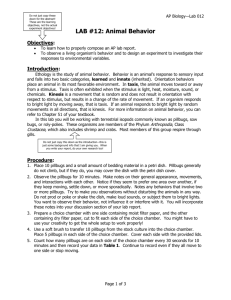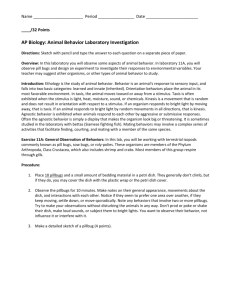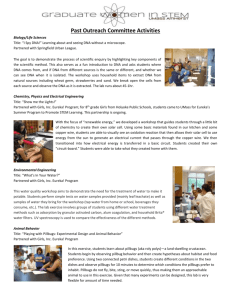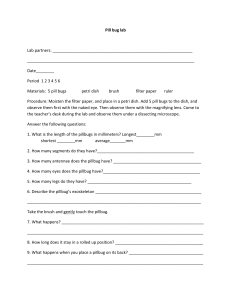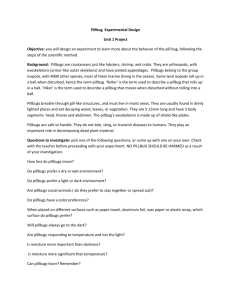Bronxville High School AP Biology Page 1 of 11 Lab 11 Mr. Ippolito
advertisement
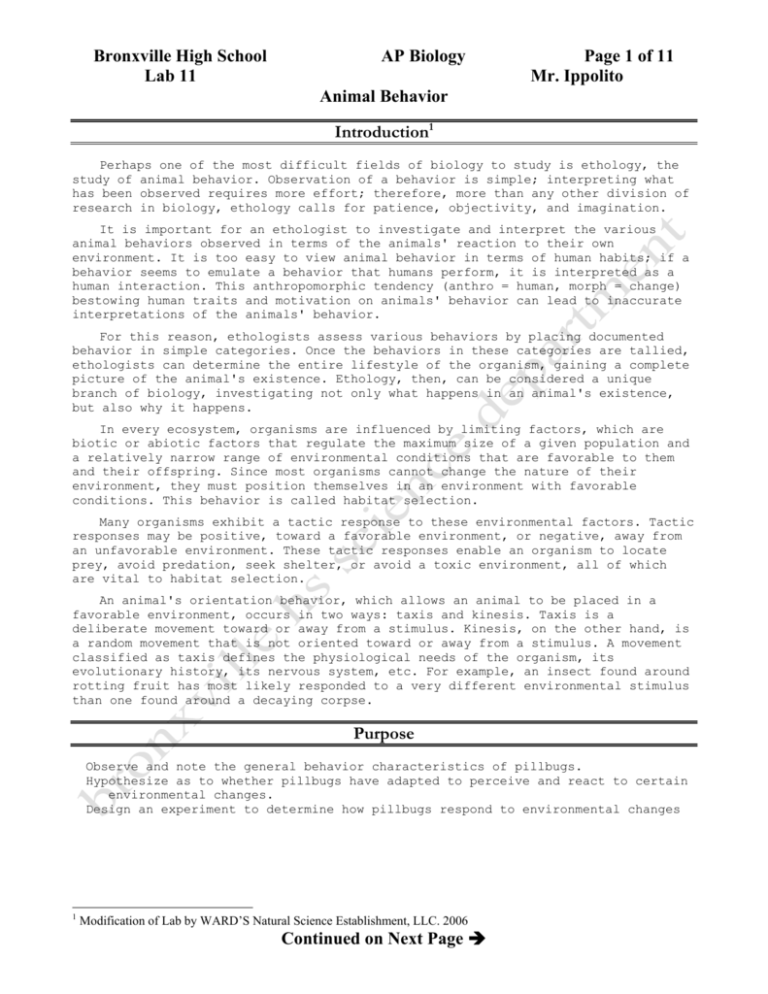
Bronxville High School Lab 11 AP Biology Page 1 of 11 Mr. Ippolito Animal Behavior Introduction1 Perhaps one of the most difficult fields of biology to study is ethology, the study of animal behavior. Observation of a behavior is simple; interpreting what has been observed requires more effort; therefore, more than any other division of research in biology, ethology calls for patience, objectivity, and imagination. It is important for an ethologist to investigate and interpret the various animal behaviors observed in terms of the animals' reaction to their own environment. It is too easy to view animal behavior in terms of human habits; if a behavior seems to emulate a behavior that humans perform, it is interpreted as a human interaction. This anthropomorphic tendency (anthro = human, morph = change) bestowing human traits and motivation on animals' behavior can lead to inaccurate interpretations of the animals' behavior. For this reason, ethologists assess various behaviors by placing documented behavior in simple categories. Once the behaviors in these categories are tallied, ethologists can determine the entire lifestyle of the organism, gaining a complete picture of the animal's existence. Ethology, then, can be considered a unique branch of biology, investigating not only what happens in an animal's existence, but also why it happens. In every ecosystem, organisms are influenced by limiting factors, which are biotic or abiotic factors that regulate the maximum size of a given population and a relatively narrow range of environmental conditions that are favorable to them and their offspring. Since most organisms cannot change the nature of their environment, they must position themselves in an environment with favorable conditions. This behavior is called habitat selection. Many organisms exhibit a tactic response to these environmental factors. Tactic responses may be positive, toward a favorable environment, or negative, away from an unfavorable environment. These tactic responses enable an organism to locate prey, avoid predation, seek shelter, or avoid a toxic environment, all of which are vital to habitat selection. An animal's orientation behavior, which allows an animal to be placed in a favorable environment, occurs in two ways: taxis and kinesis. Taxis is a deliberate movement toward or away from a stimulus. Kinesis, on the other hand, is a random movement that is not oriented toward or away from a stimulus. A movement classified as taxis defines the physiological needs of the organism, its evolutionary history, its nervous system, etc. For example, an insect found around rotting fruit has most likely responded to a very different environmental stimulus than one found around a decaying corpse. Purpose Observe and note the general behavior characteristics of pillbugs. Hypothesize as to whether pillbugs have adapted to perceive and react to certain environmental changes. Design an experiment to determine how pillbugs respond to environmental changes 1 Modification of Lab by WARD’S Natural Science Establishment, LLC. 2006 Continued on Next Page Bronxville High School Lab 11 AP Biology Page 2 of 11 Mr. Ippolito Animal Behavior Materials 10 pill bugs filter papers magnifier masking tape Procedure Note and record all observations in a data table. A: General Observations of Pillbug Behavior 1. To become familiar with the organisms, place several pillbugs in the behavior tray and carefully observe them for at least 10 minutes. In Table 1 in the Observations and Data section, document any behaviors you see. Remember to document even the seemingly unimportant behaviors. Try to document the behaviors observed in chronological order. Do not disturb the pillbugs; shaking or tipping the tray will cause unnatural behavior in the pillbugs. 2. In Table 2 in the Observations and Data section, sketch a pillbug. Label any structures that you recognize. B: Taxis 1. Place one piece of masking tape on either side of the behavior tray and label one side A, the other B. 2. Place five pillbugs in each chamber of the tray. 3. Every minute for 10 minutes, count the number of pillbugs in each chamber. 4. Record your observations in Table 3 in the Observations and Data section. 5. Calculate the average number of pillbugs in each chamber in the 10-minute time period. Enter the results in Table 3 in the Observations and Data section. Continued on Next Page Bronxville High School Lab 11 AP Biology Page 3 of 11 Mr. Ippolito Animal Behavior 6. Using the data from every group in the class, calculate the class average for number of pillbugs in each chamber in a 10-minute time period. Enter the results in Table 3 in the Observations and Data section. C. Experimental Formulation 1. You are to devise a procedure/protocol to test each of these three environmental factors that may affect pillbug behavior. These environmental conditions elicit different types of pillbug taxis: phototaxis, chemotaxis, or hydrotaxis. Phototaxis: The orientation of an organism in relation to the presence of light. Movement toward a light source is positive phototaxis; movement away from light is negative phototaxis. Chemotaxis: The orientation of an organism in relation to the presence of a particular chemical. Chemotaxis is universal in protozoa and most organisms; they avoid most chemicals and exhibit a positive taxis to some weak acids. Hydrotaxis: The orientation of an organism in relation to the presence of water. 2. Formulate a hypothesis regarding environmental preferences and how the pillbugs may react to different conditions. Enter your hypothesis in Data section of your lab report. 3. Design an experiment to test each environmental factor. To test phototaxis, vary the amount of light the pillbugs are exposed to and record their responses. To test chemotaxis, simulate an alkaline or acidic environment by placing several drops of either a weak acid or weak base on a filter paper on one side of the behavior tray. To test hydrotaxis, simulate a moist environment by placing several drops of water on a filter paper on one side of the behavior tray. 4. Check with your instructor before proceeding. Once your instructor has approved of your experiment, collect the data and enter it in Table 4 in the Observations and Data section. Input all your data into the tables assigned to you in the google.docs spreadsheet for this experiment. Be sure that there is only one possible variable present in your experiment. Multiple variables will invalidate the experiment. 5. Use the spread sheet to graph your data. 6. Using your graph and data from both the preliminary investigation and the experiments you designed, discuss your general findings and write a conclusion based on your experiment, in the Observations and Data section. Continued on Next Page Bronxville High School Lab 11 AP Biology Page 4 of 11 Mr. Ippolito Animal Behavior 7. Be ready to discuss your results with the rest of the class. Questions 1. Multi-segmented body, antennae, and color are some structural features of pillbugs. Use your knowledge of biology to discuss what advantages you think each of them might offer the organism. 2. In part B of the experiment, you placed pillbugs in a chamber and acquired data. What was the purpose of this experiment? What numbers did you expect? Why? 3. In part C, you tested your hypothesis with regards to pillbug behavior and environmental preference. Did your conclusions agree with your hypothesis? Are you confident with your conclusions or would you need to test more factors? 4. Would you describe the pillbugs response to moisture as kinesis or taxis? Why? 5. Why is it necessary for a scientist to have good observational skills and maintain a sense of objectivity when observing animal behavior? 6. While you were observing the various behaviors throughout the lab, do you think you remained objective? What did you learn about yourself as a scientist? Conclusion Remember to write a short paragraph of at least FIVE (5) sentences that explains how you achieved the purpose of this lab and answers the following questions: What did you learn? What did you like/not like about this lab? What would you change to improve this lab? Continued on Next Page Bronxville High School Lab 11 AP Biology Animal Behavior Observations and Data Continued on Next Page Page 5 of 11 Mr. Ippolito Bronxville High School Lab 11 AP Biology Animal Behavior Continued on Next Page Page 6 of 11 Mr. Ippolito Bronxville High School Lab 11 AP Biology Animal Behavior Continued on Next Page Page 7 of 11 Mr. Ippolito Bronxville High School Lab 11 AP Biology Animal Behavior Continued on Next Page Page 8 of 11 Mr. Ippolito Bronxville High School Lab 11 AP Biology Animal Behavior Continued on Next Page Page 9 of 11 Mr. Ippolito Bronxville High School Lab 11 AP Biology Animal Behavior Continued on Next Page Page 10 of 11 Mr. Ippolito Bronxville High School Lab 11 AP Biology Animal Behavior End of Handout Page 11 of 11 Mr. Ippolito
